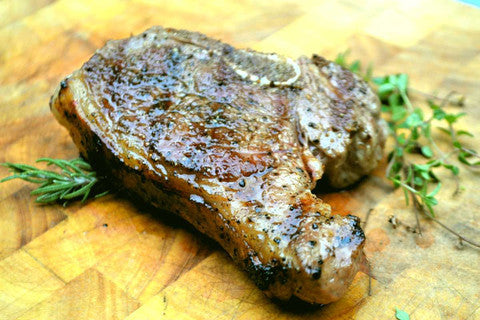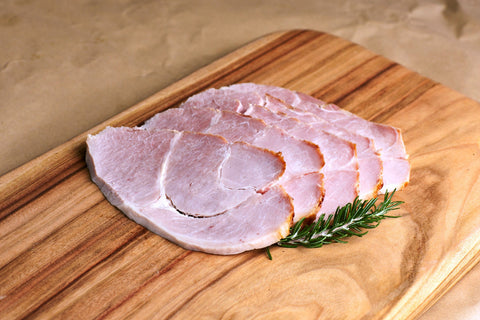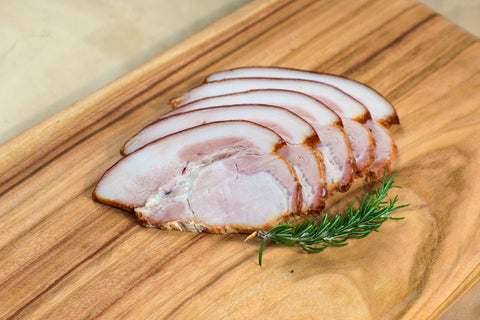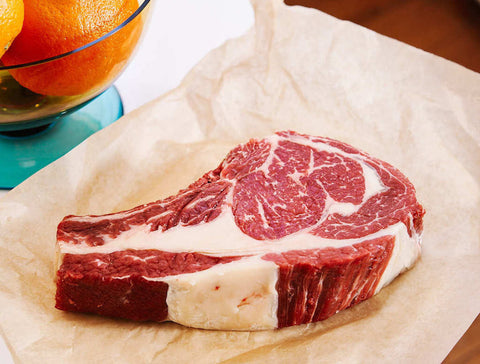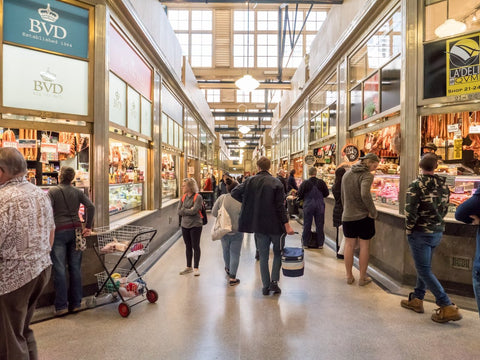Generally lamb chops come from our shops in three different cuts: mid-loin, shoulder (sometimes called BBQ chops) and chump chops. The attributes of each of these cuts are varied and ultimately due to their position on the animal.
Mid-loin chops are essentially the T-bone of a lamb; on one side you have the sirloin (aka, strip, porterhouse on a steer) and on the other side you have the much smaller fillet. Both of these muscles are prime. The sirloin has a small amount of fat and is tender. The fillet on the other side is leaner and more tender still. With mid-loin chops butchers tend to leave a long strip of fat along the sirloin side of the chop. This fat helps us greatly when it comes time to cook as it will add flavour and protect these temperature sensitive cuts.
Another chop you will find in our shops is the shoulder chop, these are cut off the back end of a lamb's shoulder where the shoulder meets the rib cage. Why do we love them? they are absolutely full of flavour. We recommend asking your butcher to cut these thinly, so that they cook quickly on the BBQ, also consider marinating for tenderness.
Lastly we have chump chops, these are cut from the rump cap and can be thought of as the same as a rump steak in Beef. A good chump chop will be tender and full of flavour. This is my personal favourite chop as its an excellent balance of flavour, fat and tenderness. The chump chop is pictured below, made up of up to four muscles and has a long strip of fat along the outer edge - as with the mid-loin this is just what we want. Most chump chops you will also find a small bone on the opposite side to the fat.
When it comes to cooking the chops listed above they can be roughly sorted into two categories: the chump and mid-loin in one group, and the BBQ chops in the second. Today I'm going to share a few tips on how to cook a Mid lion or chump chop.
- Buy good quality lamb: At Hagens all our lamb is organic, grass-fed, salt-bush lamb from local farms. If you haven’t tried the difference these attributes make then pop in to one of our shops for a chat!
- Temp your chops: This means take the chops out of the fridge at least an hour before you’d like to cook them. It also helps if you don’t leave them on a chilled plate, if you separate them out and leave on a wooden chopping board you’ll get the best and even internal temperature. Temping avoids a steep temperature gradient when you’re cooking. As we’re aiming for medium-rare we wouldn’t want the inside cold whilst the outside is burnt
- Brown: There are three things to remember when it comes to browning off: oil, moisture and heat. Browning your meat is one of the most important things to keep in mind for flavour. When you brown meat, you are caramelising the fats and sugars on the outside of the cut, this produces thousands of difference chemicals that leave your taste buds singing. Why? apparently this is a preference that goes back to our prehistoric cave-man days, we’re simply hard wired to love it, so don’t fight it, just brown your meat! When it comes to oil use a high-smoking point oil, I recommend flaxseed or rice bran. As for temperature you’re going to want to cook on as much heat as you can get, In the chop pictured use my largest burner, with a cast iron griddle for good conduction, and lastly moisture is something you want to minimise when it comes to browning anything. If there is any water or blood on your chop you will be half searing and half steaming as you cook and end up with a grey colourless chop with little flavour. Get that moisture off your chop with a clean tea-towel or paper towel.
- Concentrate heat on the fat, once you’ve achieved your desired colour on the chops main faces, you need to flip that thing over and concentrate the heat onto the fat. this will leave it soft and succulent, with a flavourful crispy skin.
- Season: I recommend seasoning your chops liberally with salt and pepper as soon as you turn each side. Extra salt on the fat is another pro tip.
- Rest: just like with your prime beef steaks, lamb should be rested, this does two things: allows the inside temperature to match the outside temp (ie come up to serving temp) and also absorbs the moisture that was being pushed out of the meat by the high pressure.

